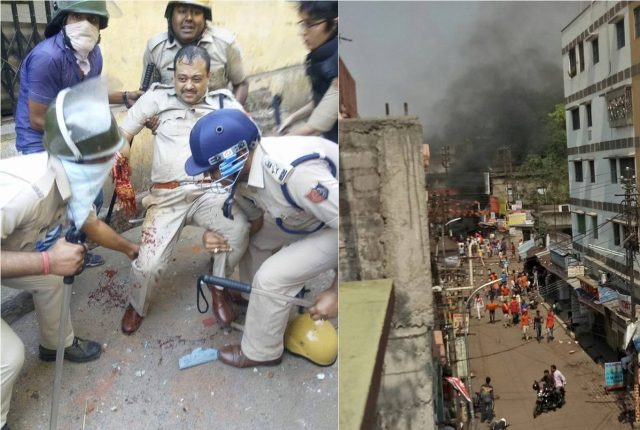
It is extremely unlikely that the average reader of newspapers — whether in English, Bengali or Hindi — would have anticipated the violence that broke out in Asansol and Raniganj in the aftermath of the Ram Navami celebrations on March 25. The media, among other things such as entertain, shock and build public opinion, is also meant to inform its readers. Unfortunately, readers, or even viewers of local television channels, had absolutely no clue that the bellicose statements from rival political parties in the days preceding Ram Navami, were more than just political posturing. The reality of growing tensions on the ground were never conveyed.
There was a temptation, particularly among a section of the ‘progressive’ Bengali bhadralok intelligentsia, to view the rising importance of Ram Navami in the State as an alien cultural import that should at best be disregarded or, worse, mocked. In one respect they were right. There was no real evidence that Ram Navami — unlike, say, Saraswati, Durga and Kali pujas or even the Rath Yatra — was a hugely popular festival among Bengali Hindus. It was at best a sectional celebration among the Hindi-speaking peoples of West Bengal. The larger question that was left unaddressed was: Why in the past two years has the importance of Ram Navami grown so exponentially among Bengali Hindus?
To view it as evidence of a growing veneration for Lord Ram is perhaps over-simplistic, although the element of faith and veneration should not be discounted altogether. What appears to have happened is, however, less to do with religiosity as with the growing quest for a Hindu identity in Bengal. In many ways, Ram Navami is becoming a political festival in West Bengal in the same way as the Ganesh festival in Maharashtra was made into a focal point of political mobilisation by Lokmanya Tilak in the early part of the 20th century.
Why has this transformation taken place? To locate the reasons we will have to look at the growing perception among Bengali Hindus that the cultural (which also includes religious) identity of the State is being changed unrecognisably thanks to what can best be called the ‘appeasement’ politics practiced by Mamata Banerjee.
The genesis of the fear predated the victory of the Trinamool Congress in the 2011 Assembly election. The issue of a steady influx of illegal migrants from Bangladesh had been agitating Bengalis since the early-1990s. The CPI(M)-led Left Front was aware of this rising concern but preferred to look the other way. At the same time, however, the Left Front Governments took exceptional care to put a lid on the activities of Muslim fundamentalist bodies. Care was always taken to ensure that Muslim assertiveness did not go out of control. Although this approach wasn’t always successful, the CPI(M) ensured that fundamentalist bodies were firmly kept out of the exercise of political power. This was almost exclusively vested in the local party units.
Mamata owed her victory substantially to a significant shift in Muslim votes away from the Left Front as a consequence of Buddhadeb Bhattacharjee’s growing impatience with Muslim fundamentalist bodies. However, she went a step further. The TMC being an undisciplined political force, she had very little inhibitions in conceding political space to the Muslim bodies. In matters pertaining to recruitment of State Government employees she displayed a marked pro-Muslim tilt, a phenomenon that began to be widely commented on. Secondly, on issues such as the Kaliachak riots, the State administration chose to be soft towards instances of organised criminality by Muslim communities. She also tacitly encouraged the inflammatory comments of sundry maulvis. Finally, in recent months, local TMC units — or at least those who take refuge under TMC flag — have sought to exploit the Rohingya crisis in India’s eatern borders to facilitate the silent but organised trickle of these Muslim migrants from Myanmar via Bangladesh. The news stories of an organised Rohingya influx into West Bengal has agitated Bengalis and furthered the perception that the State is now hostage to sectional Muslim demands.
The fact that real grievances of ordinary Bengali Hindus, not necessarily linked to the BJP which has yet to acquire deep roots in West Bengal, have been given short shrift has contributed to a sense of victimhood among the local Hindus. The feeling that Hindus have been left orphaned as Mamata panders to her vote banks has become a new factor in local politics. This explains why, when the opportunity presents itself, there has been a spontaneous Hindu assertion. The Ram Navami explosion is a manifestation of this.
The whole thing has become even more complicated by the policy of steadfast denial pursued by the wielders of intellectual capital. With the ‘secular’ news media either ignoring Hindu disquiet or burying it under heaps of condescension, the new Hindu mobilisation has been forced into subterranean channels — a reason why its potential is explosive. Asansol is not the first communal clash in recent months. There were vicious communal clashes in Kharagpur, Basirhat and countless unpublicised incidents all over the State. But the root cause of why sectarian tensions are escalating have been left unaddressed.
For Mamata, anxious to find a national role for herself, the incidents in Asansol and Raniganj should be a cause of worry. The deep wounds caused by cynical politics can no longer be healed by invocations to a high secular tradition. History will tell us that there are alternative intellectual traditions that can be resurrected too.
By Swapan Dasgupta














